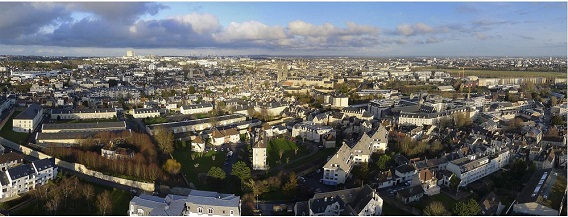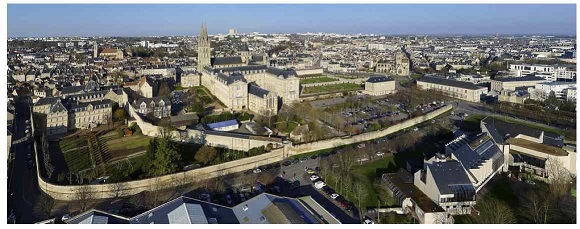| International Workshop on Nonlocal Models, PDEs and Applications 13 - 14 May 2019 Caen, Normandy, FRANCE |
|
|
|
Local AttractionLocated between land and sea, 2 hours from Paris and 10 minutes from the beaches, on the road to Mont Saint-Michel, Caen is a lively and dynamic metropolis that combines a rare wealth of heritage and culture with many tourist infrastructures and high quality .
The Castle of Caen Visit the castle of Caen, in the heart of the city center. Listed among the largest castles in Europe, the former palace of William the Conqueror now houses the Museum of Normandy and the Museum of Fine Arts Caen. The castle: built in 1060 by order of Duke Guillaume le Bâtard the fortified residential palace spread over more than 5 hectares. Stroll on the ramparts and enjoy a magnificent panorama of Caen. Inside the ducal castle, visitors will survey the Echiquier Hall, the Governor's House (now the Normandy Museum), the Saint Georges Church and the Jardin des Plantes, also known as the Jardin des Simples. The Abbayes-aux-hommes (Bourg l'Abbé)
The museum of initiation to nature is located in the enclosure of the Abbey-aux-Hommes, built in the eleventh century, at the initiative of William the Conqueror. But the architectural ensemble is made up of buildings from very different periods. In the garden of the museum, you can observe the military protection compound, built during the 100 Years War, on which builds the old cart. Leaving the garden, you will come face to face with the guard room of the Abbey, a Gothic style religious building, built in the fourteenth century. The monks used it as a meeting place and for official assemblies. Next door, the corner pavilion is a more recent construction, classic style, completed in 1844 following the model of convent buildings (cloister, refectory, scriptorium), rebuilt in the eighteenth century. Under the First Empire, the place hosts the Imperial High School, future Malherbe High School. Then head left, then right at the end of the driveway. Walk along the convent buildings of the abbey, and finish this short, but rich walk by observing the majestic façade and the two spiers of the Saint-Etienne church.
Le manoir des Gens d'Armes Built at the beginning of the 16th century, for Gérard de Nollent, the Gens d'Armes manor (also called Nollent or Talbatières) had four towers connected by crenellated walls. In the center was the house. This small "castle" with false markets and Florentine gate windows was actually a resort and pleasure on the banks of the Orne. It owes its current name to two statues that surmounted the entrance tower. Although the walls were destroyed on three sides, this fortification has retained a certain charm. Le quartier de l’Abbaye-aux-Dames (Bourg l’Abbesse) The Abbaye-aux-Dames are places that have been home to the Lower Normandy Region since 1986. These buildings in which the future of our region is built are also witnesses to its rich past. This Benedictine abbey testifies to the splendor of ducal Normandy. Since 1986, its former convent buildings have been home to the services of the Region, which work daily for the future of Lower Normandy. Le musée de Normandie The Normandy Museum of Caen presents the history of the region illustrated by archeology and ethnology. Remarkable collections of objects are exhibited thus tracing the stages of the history of Normandy since prehistory. The museum presents the life of men from the Paleolithic until the arrival of the Vikings in the lower valley of the Seine. The archeological rooms contain collections of weapons, jewels, objects of everyday life all placed in their context. Ethnological collections tell the life of the Normans from the 18th century to the present day. Le Bassin Saint-Pierre It is one of the five basins of the port of the city. Settled in the course of Odon around 1845 and completed by the construction of the Canal de Caen to the Sea in 1857, it is a place of leisure to discover during your stay. This site is one of the popular activities of visitors to the area. Le musée des Beaux-arts The Musée des Beaux-Arts in Caen presents works from the Italian and Flemish Renaissance to the present day. European Renaissance works of art are exhibited including paintings by Veronese, Tintoretto, Poussin, Champaigne and Rubens. He also presents to the public prints from the Mancel collection. The Museum of Fine Arts in Caen also organizes conferences. The museum's conservation library, consisting of more than 20,000 volumes related to art history, is open to the public. You will discover the remains of the Duke-King's palace and dungeon, or the Hall of the Exchequer. the visit takes place from Tuesday to Saturday. L'Abbaye-aux-Dames
It is one of the two great abbeys of Caen. Founded around 1059-1060 by William the Conqueror and his wife Mathilde of Flanders, the former Benedictine Abbey of the Trinity of Caen stands on top of the hill overlooking Caen the confluence of the Orne and Odon. The abbey is the seat of the Regional Council of Basse-Normandie since 1986. |



